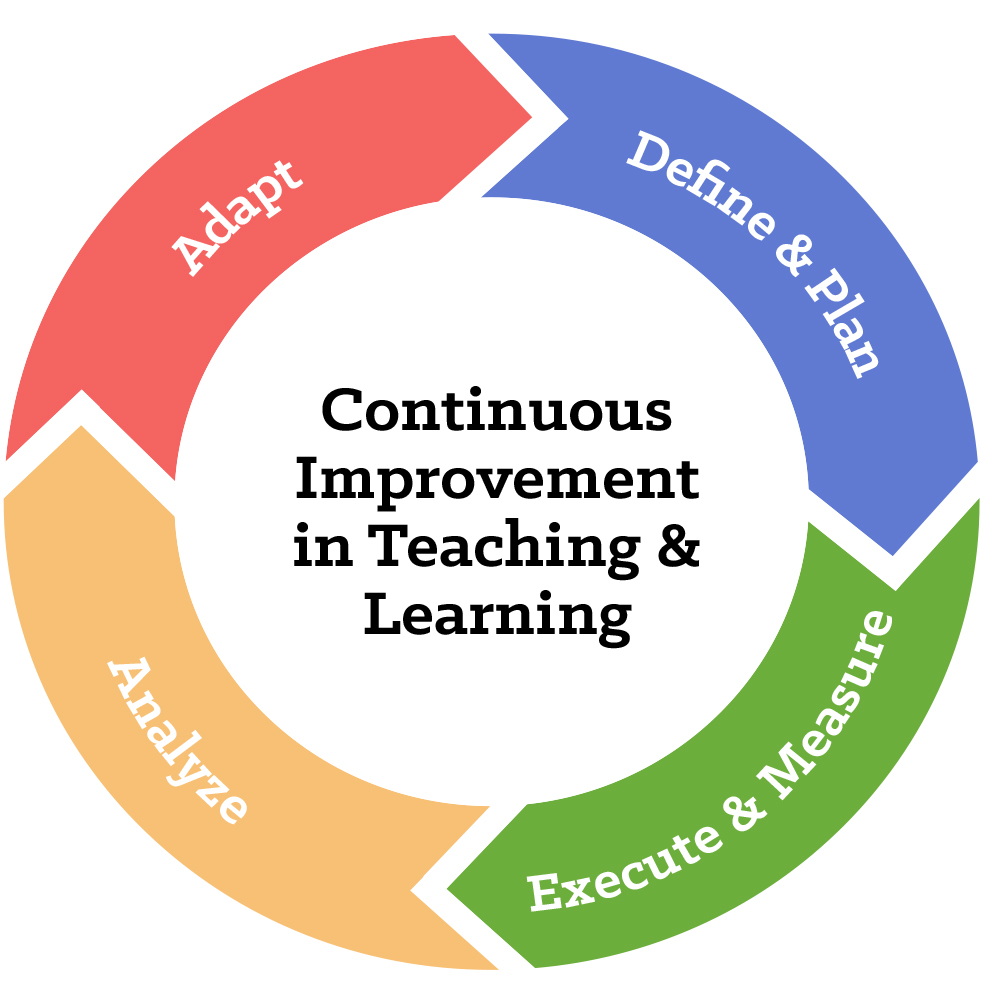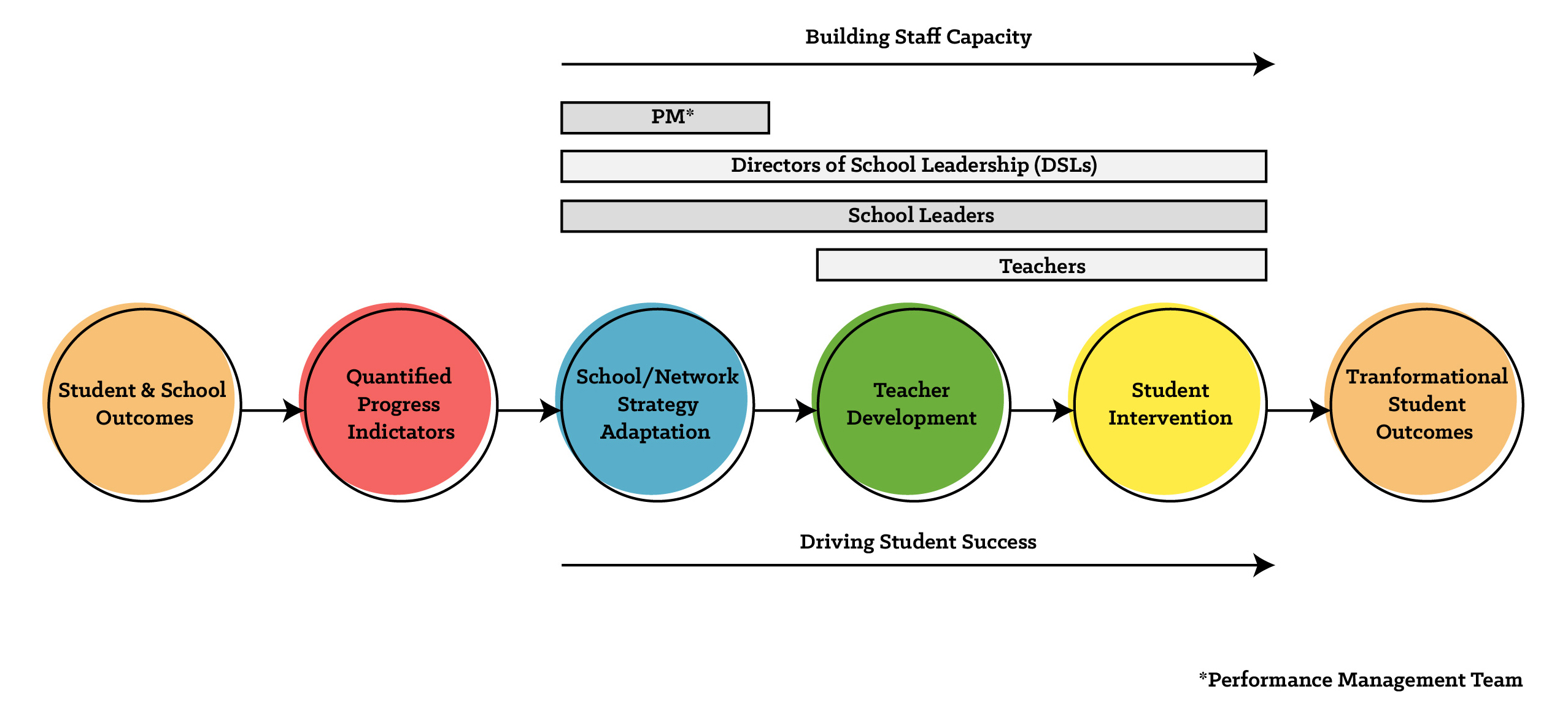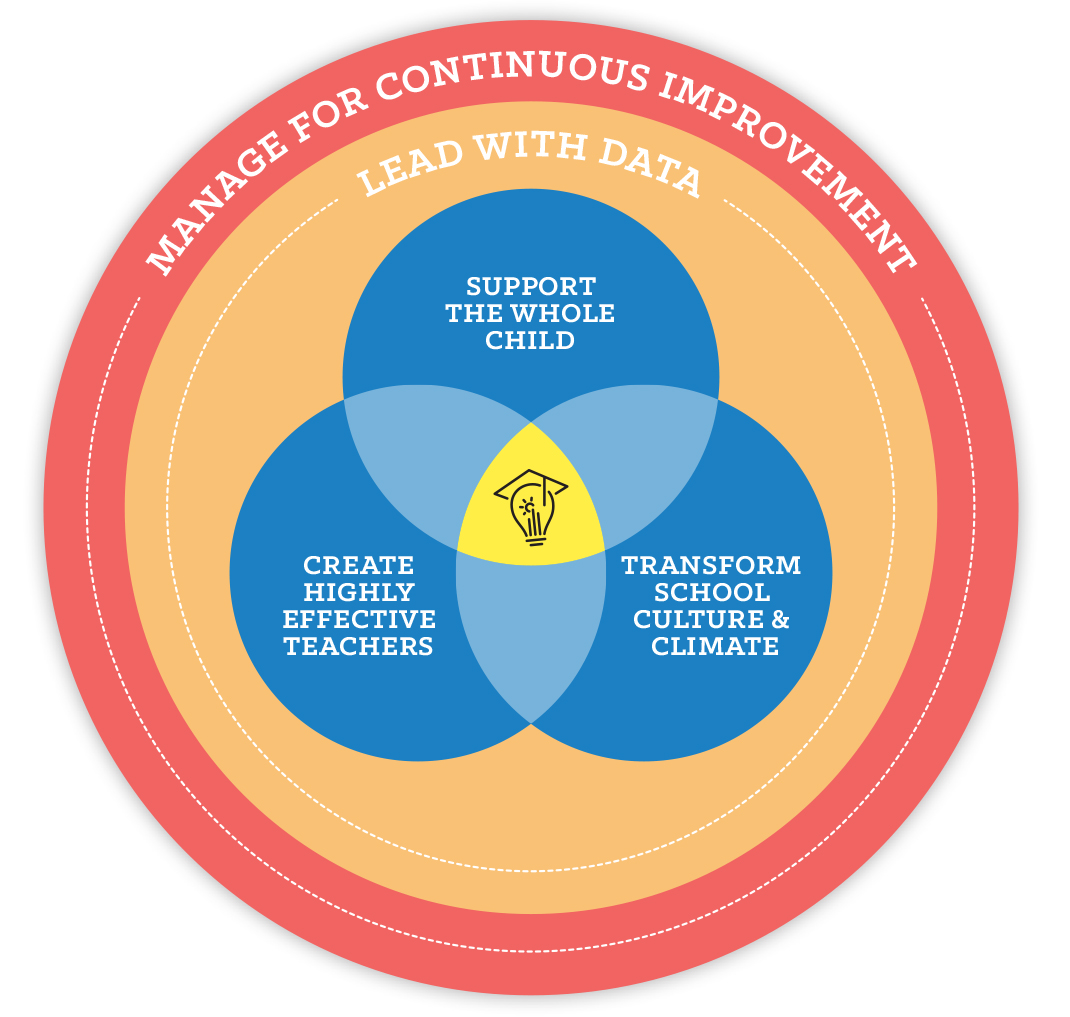Over the last several decades Chicago, and our country at large, has wrestled with the challenge of providing access to a high-quality and equitable public education for all children. Public education reform efforts have come and gone, and many (whether intended or not) have seemingly exacerbated the difference between the students and communities, the haves and the have nots.
A key factor that has emerged and persisted in better serving all students is leading reform using student and school outcomes data. One primary application has been to hold educators accountable for the learning happening in the classroom. However, the challenge remains that while recent efforts have clarified the ends (or desired educational outcomes), the means by which systems, networks, schools, and classrooms achieve those ends have been varied and inconsistent.
Many organizations, when thinking about using data as a lever to deliver on the promise of high-quality and equitable public education at scale, have developed little by way of clear and replicable strategies to capture the full potential of the opportunity. As a result, we have seen correspondingly varied and inconsistent impacts on student outcomes.
As an innovation zone working in partnership with Chicago Public Schools (CPS), we at the Academy for Urban School Leadership (AUSL) are focused on leveraging data across our efforts to train new teachers, develop teacher and school leaders, and transform the school environment to enable high-quality teaching and learning to occur -- and we have been doing this successfully for nearly two decades.
Our Story
We began as the nation’s first urban teacher residency program in 2001, when civic-minded entrepreneur Martin (Mike) Koldyke, alongside then CEO of CPS Arne Duncan, saw an opportunity to affect real change in education by training highly-effective teachers who would be ready to teach in at-risk schools across Chicago. Through a combination of intensive classroom learning and student teaching under the mentorship of experienced teachers at an AUSL/CPS training school, residents graduate from the one-year program ready to hit the ground running.
In 2006, we, along with education leadership in Chicago, recognized that transforming teacher talent alone wouldn’t suffice in improving educational outcomes. So, we expanded our scope and became the first non-profit organization in the country to contract with a large urban school district to holistically transform its lowest-performing schools. Today, we have trained more than 1,000 teachers, actively manage 31 CPS schools across the South and West sides of Chicago, and share our best practices with struggling districts across the country (more than 40 to date) through our Advisory Services.

AUSL's innovation framework, summarizing the five pillars that guide their work.
As our work has evolved, our focus has always remained on our students, and our commitment to their education. Driving us towards that has been our innovation framework -- each pillar of which is a reflection of how we support our students -- the heart of which is leading with data.
Our Solution and Approach
Our focus on data is firmly grounded in and driven by school and student outcomes, as well as the indicators that provide directional insight into our progress against those high-level goals. We have developed an organizational culture wherein data permeates our real-time and action-focused continuous cycle of feedback and intervention.
And it is by building the capacity of leaders to use data on an ongoing basis, and fostering alignment and investment in continuous improvement across all levels of the organization (the network, schools, and classrooms) that we are able to drive student outcomes.
Our continuous improvement cycle pivots on four key elements: 1) Define and Plan, 2) Execute and Measure, 3) Analyze, and 4) Adapt.

AUSL's continuous improvement cycle.
In and of themselves, these steps are not revolutionary. What we believe sets our approach apart is the data-driven organizational structure that underpins this cycle and allows us to take full advantage of its potential.
Our cycle begins with selecting meaningful data points that we believe comprehensively reflect educational outcomes we would like to achieve for our students. Examples of progress indicators are: attendance, formative assessment, and course performance, as well as summative outcomes such as grade-level proficiency and growth, high school on-track indicators, and postsecondary success measures. In addition, we target school performance against Chicago’s School Quality Rating Policy (SQRP) and teacher development using our internally-developed measurement tools.
After completing a holistic review of the data, we intentionally plan targeted teaching and learning (e.g., instructional, classroom, school, and network) strategies. While this process is led and facilitated at the network-level, adjustments are made by school leaders based on the context of each school -- accounting for unique school circumstances. Messaging cascades throughout the organization to ensure that all individuals impacting students understand both the what and the why of their work -- along with the indicators and strategies that will be used to drive them.
As schools execute their plans, we measure performance by gathering quantitative and qualitative data. Both components are key to ensuring we comprehensively assess all of the available information to inform adaptations and adjustments.
Two things happen at this stage:
- Our performance management team gathers, organizes, and derives initial insights from leading indicators and projected outcomes. The team leverages district and AUSL-developed tools such as dashboards and calculators to measure both quantitative (e.g. attendance) as well as qualitative (e.g., observations of teachers, classrooms, school environment) indicators. This data acts like a heat map and is used to identify high-level areas for further discussion, exploration, and intervention.
- Teachers receive continuous coaching and feedback from instructional and curriculum coaches, and their Principals. Additionally, principals receive individualized coaching from their Director of School Leadership (DSL; principal managers overseeing 5-8 schools in our network). This feedback system ensures that everyone is working on their own professional development.
The key avenue by which these critical conversations take place is through the regular collaboratives (dedicated spaces bringing together school and instructional leaders to reflect and plan interventions). During these day-long professional development sessions, the performance management team and coaching leaders partner with school leaders to analyze and adapt current strategies. The collaboratives also, and most importantly, provide space and time to develop the capacity of principals and teacher leaders to drive similar continuous improvement cycles on an ongoing basis in their individual school buildings.
After interventions have been identified and implemented, the cycle restarts to measure the impact of new approaches against the defined progress indicators and projected outcomes.

A key driver of AUSL's success has been to build the data capacity of staff while adapting approaches to improve student outcomes through the continuous improvement cycle.
Our Impact
Late in 2017, Sean Reardon, Stanford University Professor of Poverty and Inequality in Education, released research showing that CPS elementary students were achieving faster learning gains than 96 percent of school districts in America. Since the release of his findings, researchers and education experts have been searching for the underlying reasons why CPS schools are making such remarkable improvements. Recently, the Joyce Foundation released a report that begins to explore the answers to this question.
The Joyce Foundation report recognizes that we have been credited by some experts as one of the factors contributing to one of the nation’s most challenged school districts transformation. This recognition comes on the heels of two 2017 papers from The Bridgespan Group, global nonprofit consultancy dedicated to social sector change, praising us as an “innovation zone” (iZone) for our innovative approach to transforming schools from inside a public school district.
Over the past decade:
- Every year since the introduction of the SQRP, we have increased the percentage of schools meeting Good Standing performance benchmarks (Level 2+ or better). It is important to reiterate that our schools, when we initially contracted to manage them, were some of the lowest performing schools in the city, if not the state, with a predominantly Black, Latino, and/or low-income student population.
⋅ 81 percent of our schools met these benchmarks for the 2018 school year, up from 41 percent in 201. We now have a higher percentage of schools rating 2+ or higher than CPS as a district.
- We have consistently increased the percentage of elementary students at or above grade level over the past five years. Using the MAP assessment (the standardized test used by CPS to gauge student attainment and growth) our gains have exceeded CPS’s average in all categories:
⋅ Math (2-8): +13pp vs. +11pp
⋅ Reading (2-8): +18pp vs. +16pp
⋅ Math (8th Only): +21pp vs. +17pp
⋅ Reading (8th Only): +26pp vs. +24pp
- For the 2016-2017 school year:
⋅ Our high schools have closed the gap with CPS in terms of freshmen on-track -- the biggest predictor of high school graduation.
⋅ Our seniors are enrolling in college at a rate on-par with the rest of CPS and earned $55 million in scholarship dollars.
Our Concluding Thoughts
Public education in our country is built on human capital. Even today, with technology at our fingertips, the human factor in making informed, multi-faceted decisions is irreplaceable. Therefore, any lever identified to impact student and school outcomes must incorporate and leverage this human capital to maximize its impact. The adults in our networks and schools are the ones that drive the work to deliver high-quality education to each and every student. As an organization, our theory of change rests on these adults who in turn create environments that foster high-quality learning. And we believe a key element of our success in realizing this level of impact on our students has been building the capacity of these adults -- by providing the tools and space necessary to understand and leverage data to inform decision-making.
The challenge of delivering on a high-quality and equitable education is multi-faceted and incomprehensibly complex. This approach of focusing on better leveraging and embedding data into the fabric of our organization and our people is but one avenue by which this challenge can be overcome.
We are thrilled at the sustained progress our students are showing, and at the prospect that our innovative model is working against this challenge. However, we recognize this work doesn’t end – that the impact of the years and generations of communities being underserved cannot be reversed and righted in two, ten, or even twenty years. But, in today’s world, by sharing what works and learning from others committed to the same outcome, we can push the needle further and faster than ever before.


